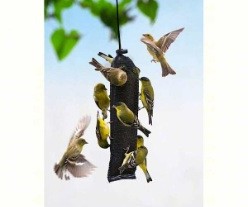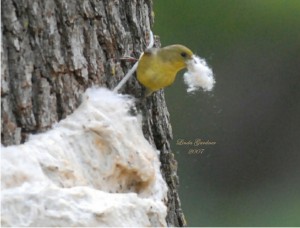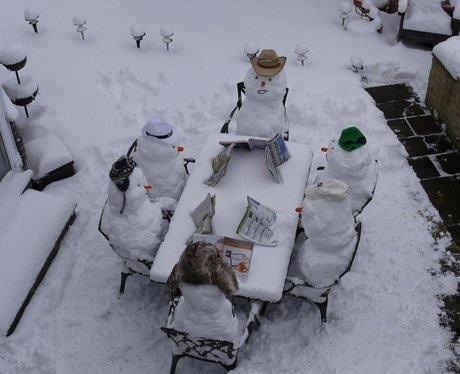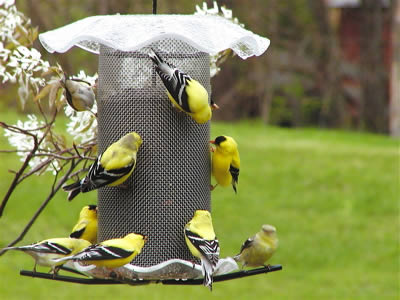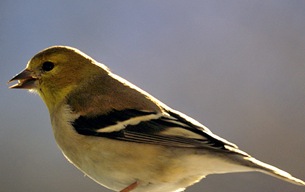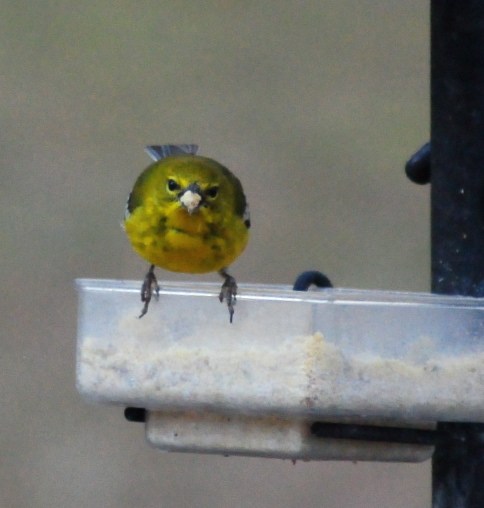-
Thistle Feeders are in High Gear Once Again!
It may be officially summer, but the tail end of spring nesting season is still going strong. Goldfinches are just starting to nest now, which means you’ll be seeing a whole lot of yellow at thistle feeders in the next 2-3 months.
If you’re not offering thistle yet, you may be missing out! The American Goldfinch is a favored backyard songbird as their summer plumage, friendly disposition and sweet song are simply a pleasure to have around the garden. And unlike other birdseed, thistle seed won’t germinate… which is also a pleasure in the garden 🙂
Goldfinches don’t use birdhouses, so there’s no luring them in with that. They’ll raise their broods in mature hedges or trees, constructing nests of woven plant fibers and down. You can encourage them with some nesting materials placed in the vicinity of thistle feeders. They’re partial to Hummer Helper, the hummingbird nesting material, feathers and other fibrous nest offerings.
Unlike some more aggressive birds, goldfinches are quite demure, they’d rather fly off than fight for a spot at the feeder. This where lots of perches, or an all-over feeding space to accommodate them are ideal. Thistle socks are another great choice for goldfinches’ busy time of year. You can easily offer several different feeding spots, without spending a whole lot! Parents will feed babies thistle seed almost exclusively at first, sometimes mixed with finely chopped sunflower bits, you’ll see finches consuming this seed mix too.
As always, fresh water is critical to any bird’s environment. Keeping your bird bath clean is important stuff, for them and for your yard – especially in warm summer weather. Keep water shallow (no more than two inches) and keep it fresh… and they will come!
Oh wait, once goldfinches molt again in September they’ll turn an olive-drab color… but don’t quit feeding them. If you offer thistle year-round, their electric yellow plumage will grace your yard every summer!
-
Can You Spot the Thistle Feeders?
Me neither as they must be covered in snow and awaiting the big thaw. So this is April? Wisconsin, Minnesota, somewhere like that. Goldfinches are already shedding worn winter feathers and turning yellow, while other common resident birds are nesting in much of the country. Once again, will winter ever end?
Yesterday brought our first butterfly to the yard, but unfortunately the consecutive, way below normal night temperature this year zapped established lantana that was seven years old. You could always count on butterflies around those shrubs. Yes, that’s how big they were, mature shrubs.
Erratic weather is largely attributed to climate change, but many folks don’t see it that way. Mudslides, volcanoes, drought and rising sea levels to name a few effects are pretty apparent and scarily becoming the norm.
In the bluebird world, trail monitors found a record number of dead bluebirds in the KY area. A very late spring being the culprit after such a rough winter… there were simply no natural food sources available. Someone was inquiring about a feeder the other day and said “no rush, it’s for next year, we don’t really feed birds in summer”. We’ve come across many folks like that, but here’s the reality: weather directly affects food sources and bird’s survival rates.
Last summer through a wicked drought, we witnessed a male cardinal feeding a fledgeling from a platform feeder containing
sunflower hearts. From ground to platform and back he flew feeding his offspring. It was a strange sight, as others were reported this winter too. Cardinals hanging on suet feeders, and ground-feeding juncos up at black oil feeders. Many of the migratory birds were in for a harsh surprise upon arrival into the gulf states. No flowers, no berries, no insects, simply an equation for starvation after a long journey like that.
Closer to home, resident birds braved a very tough season as well. Feeders were non-stop with activity for the most part. Although thistle feeders didn’t see too much traffic, other feeders containing finch mixes did… and a lot! Once the olive drab fliers began their molting process, straight nyjer became goldfinches’ food of choice and overnight, thistle was and is being devoured daily!
The good news is this seed has come down in price a little bit, and if you can manage the larger bags, like 20-to 40-pounders, you’ll save even more money this summer. Unlike other birds, goldfinches feed nestlings and fledgelings thistle-almost exclusively.
So if you’re not really a “summer feeder”, you may want to rethink maybe just one or two feeders this summer… the bird families sure will thank you!
-
Got Your Nyjer Feeder Ready?
Goldfinches are back in droves.. but they’re not quite so gold yet. Still sporting drab winter plumage, it’s not until late spring/early summer when they’ll molt again. It’s the process of shedding old worn feathers to make way for new ones, and goldfinches happen to be one of very few birds who molt twice per year.
If your nyjer feeder has been sitting for a while sans activity, the older seed may be moldy, and finches won’t eat it. Consider trashing that old seed, giving the feeder a good cleaning and refilling with fresh goods. Doing this provides a welcome sign for these cool little birds.
One of the larger capacity feeders is shown here – holding 5+ lbs. of seed. A relative of the Rainbow Finch Feeder, the Super version is even better for large finch crowds. With colorful perches and a great design, this nyjer feeder lets you fill from both the top and bottom. This eliminates stale seed piling up at the bottom. By alternating which end is filled with fresh seed, there’s never a build-up of old stuff.
There’s another bird out there now who might easily be confused with the goldfinch. About the same size, but very opposite behavior, warblers can be pretty territorial around bird feeders. Males will fight and fend off others, doing this sort of vertical flight dance where the birds look almost intertwined. Goldfinches on the other hand would rather find another feeder than fight.
This is when an extra thistle sock or two come in very handy. Inexpensive and simple to use, they offer extra feeding spots during goldfinches’ busy breeding season. Oh and this warbler… he’s got a mouthful of suet and a big attitude too!
To roll out the welcome mat for finches and other songbirds, offer a consistent fresh water source and keep bird feeders clean. Adding some nesting materials in early spring will also encourage residency at your place!


